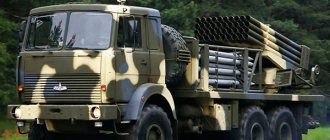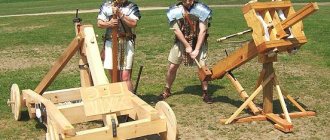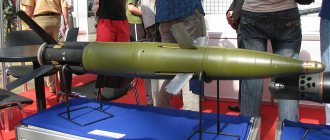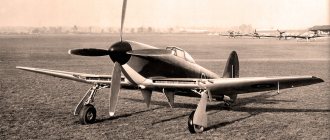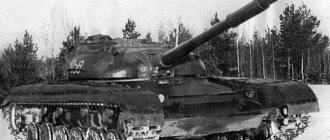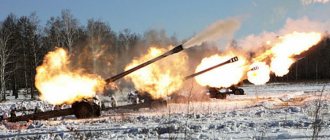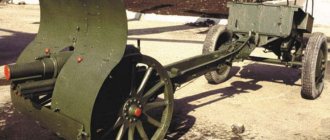Comparison
The gun has a long barrel and a high muzzle velocity, making it convenient to use to hit moving objects. In addition, the cannon has the longest range of all types of guns. The gun's barrel elevation angle is small, and therefore the projectile flies along a flat trajectory. Such features make the gun very effective in direct fire. When firing fragmentation shells, the cannon is good for disabling enemy personnel (being at an acute angle to the surface, exploding, the shell covers a large area with fragments).
180 mm S-23 gun
The howitzer is primarily used for overhead shooting, while the servants often do not see the enemy. The howitzer's barrel length is shorter than that of a cannon, as is the gunpowder charge, as well as the initial velocity of the projectile. But the howitzer has a significant barrel elevation angle, thanks to which it can be used to shoot at targets located behind cover. Also, a howitzer is more profitable financially: the walls of its barrel are thinner, it requires less metal for production and gunpowder for firing than a cannon. The weight of a howitzer is much less than the weight of a gun with the same caliber.
The gun is more suitable for defensive actions. A howitzer, on the contrary, is for offensive purposes - it is capable of causing panic behind enemy lines, disrupting communications and control, and also creating a barrage of fire in front of its own attacking troops.
122 mm howitzer D-30
Mortar's swan song
Mortars - large-caliber guns with a short (15 caliber) barrel, throwing their shells along a hinged trajectory, were born along with the bombard. Just like her, the mortar fired stone cannonballs. But only her shells fell on the enemy’s head, flying over the walls of castles and fortresses. And if these walls themselves could at least somehow protect their inhabitants from bombard cores, then it was impossible to protect themselves from mortar fire. The Vienna Military History Museum displays the Pumhard mortar from the early 15th century. Its caliber is 890 mm, that is, it is equal to the caliber of our famous “Tsar Cannon”, and it fired a stone cannonball weighing 800 kg! But although no roof could protect against it, it soon became clear that it was not a very effective weapon for war. After all, the stone cores did not explode! Therefore, the military soon decided to shoot hollow cast-iron “bombs” filled with gunpowder from mortars. To ignite the charge, a ignition tube with pressed gunpowder was used, which the powder gases, escaping from the barrel along with the projectile, were ignited immediately at the moment of the shot. The bomb was flying, and the tube was burning, and when it fell, then... after some time there was an explosion. Moreover, the defeat was inflicted both by its own weight and by the explosion of its charge. Peter I, however, ordered the gunners to “first light the bomb in the mortar, and then light it behind it,” which was quite dangerous, but it gave confidence that the shell would definitely explode. The effectiveness of mortar fire was very high, especially if it was necessary to shoot at fortifications. After all, the British and French during the siege of Sevastopol during the Crimean War had no superiority in artillery over the defenders. On the contrary, it was at the Russian garrison besieged by them! But only the Sevastopol residents basically had cannons that fired cannonballs flatly, and the allies, who outnumbered the fortress defenders in the number of heavy mortars, bombarded them day and night with destructive explosive shells. And their fire was so effective that our troops had to leave Sevastopol! They were also used in the navy, on special bombardment ships or, as they were also called, “bomb ketches.” They had deck reinforcements and several heavy mortars. They fired at coastal fortifications, but also at the enemy fleet. Of course, it was more difficult to hit an enemy ship from a mortar than from a flat cannon, but on the other hand, a hit from an explosive bomb caused incomparable damage. The bomb pierced the deck, or even more than one, and exploded inside the ship, which often led to a fire.
At the same time, the weight of the mortars was very large, and their installation in positions required a lot of time. When firing, they jumped strongly, causing their aiming to be lost. For example, the 330-mm Dictator mortar, which the northerners used during the siege of Petersburg in Virginia in 1864, is known; it weighed 7.7 tons, so it was even placed on a railway platform. The projectile weighing 100 kg was lifted by two people with special pliers, and its carriage served as a ladder.
We can say that it was the war between North and South that became the “swan song” of smooth-bore mortars. Then mortars became rifled and at times acted quite effectively, but their role steadily declined. Well, today mortars have become the property of museums, where a lot of them are stupid, “yawning,” heavy and often huge. Well, it’s very interesting to look at them, and that’s what we’ll do now.
Here it is, the Pumhard mortar from the Military History Museum in Vienna. It is clearly visible that it is made of two layers of iron. The inner layer is made of strips laid lengthwise, the outer layer is made of rings placed on it, that is, located transversely. The outer rings were put on while hot, so that when they cooled, they tightened the barrel, giving it greater strength.
Another forged mortar from the Army Museum in Paris. Around 1450. Length: 2 m, caliber 486 mm. Weight: 1,500 kg, core weight 130 kg, firing range 100-200 m.
Then the mortars began to be cast from a special copper alloy. And the imagination of some craftsmen from the possibilities of casting ran so wild that such examples appeared as this 18th century mortar, made in India for Tipu Sultan (“Tiger of Garbage”), which today is in the Royal Artillery Museum in Woolwich, England .
Spanish mortar on a metal carriage of the 18th century. in the Historical Museum of Cordoba in Argentina it also looks quite “modern”.
The French mortar of 1828 was also cast in bronze.
But this is our Russian 335-mm mortar of 1805 from the Artillery Museum in St. Petersburg.
An absolutely monstrous mortar used during the siege of Antwerp in 1832, designed by Henri-Joseph Pecsan.
English mortar from Fort Nelson.
British artillerymen are firing at Sevastopol with 13-inch siege mortars.
The famous American mortar "Dictator".
Virginia, Yorktown, mortar battery position No. 1.
Richmond, 1865, 8-inch mortar 1841
Federal mortar battery of 1841 10-inch mortars on Morris Island in Charston Harbor.
Appotomax River, Virginia. Confederate 24 pound mortar.
10-inch mortars of 1841 of the northerners.
It is interesting that these German mortars displayed in the citadel of the Spandau fortress do not have any devices for raising the barrel, so they are cast together with the carriage, like Tipu Sultan’s gun. Obviously, the range was adjusted by changing the charge.
London, Woolwich, Greenhill Terrace: a unique Mallet mortar from 1854 with a caliber of... 920 mm!
Sign on Mallet's mortar. As you can see, she successfully fired 19 times! But she didn’t fight!
Then rifled mortars appeared, and the same Americans thought of using them against the fleet. They placed 305-mm mortars of the 1890 model in such “mortar pits” that it was absolutely impossible to hit with flat fire from ships! Fort Desoto, Florida.
And so these mortars fired... Photo from 1915.
Conclusions TheDifference.ru
- A cannon is an artillery weapon for flat firing with a high initial projectile velocity.
- Howitzer is a type of weapon for mounted firing from closed positions.
- The cannon's barrel is longer than that of the howitzer.
- The initial speed of a cannon is higher than that of a howitzer.
- It is most convenient to use a cannon to hit targets that are moving and located in open areas.
- The howitzer is designed for mounted firing at hidden targets.
- The cannon is the longest-range type of weapon.
- A howitzer is lighter than a cannon with the same calibers, and the powder charge of its shells is less.
- The gun is good in defense, the howitzer is good in attack.


